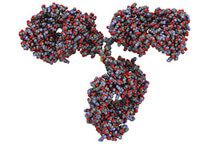Monoclonal Antibodies Vaccines(mAb Vaccines)
Future of Biopharmaceutical market for Therapeutic Monoclonal Antibodies looks very bright. Since the award of a Nobel Prize for the technology that enabled the preparation of monoclonal antibodies in 1984, their utility has expanded far beyond their scientific use; they have become highly valuable therapeutic agents. Monoclonal Antibodies directed against cancer and autoimmune diseases are burgeoning and this is a huge growth area due to the success of drugs already on the market. Thus, the use of monoclonal antibodies is expected to grow exponentially in days to come. Generating annual sales of almost $122bn per year today, monoclonal antibodies continue to play a vital role in the biopharmaceutical development and represent 42% of the total pharmaceutical market.
Our target mAbs: Adalimumab, Trastuzumab and Infliximab.
 Monoclonal Antibody(Immunoglobulin G, IgG2a, mAb) molecule, chemical structureThis is primarily driven by the oncology and autoimmune disease treatments. A series of Animal Room Facilities, including Specific Pathogen Free Barrier facility, Transgenic Animal Facility, will be used for Monoclonal Antibody Vaccine production, infectious disease research and Gene Knockout Studies.
Monoclonal Antibody(Immunoglobulin G, IgG2a, mAb) molecule, chemical structureThis is primarily driven by the oncology and autoimmune disease treatments. A series of Animal Room Facilities, including Specific Pathogen Free Barrier facility, Transgenic Animal Facility, will be used for Monoclonal Antibody Vaccine production, infectious disease research and Gene Knockout Studies.
The overall goal of our mAbs program is to develop a reliable and reproducible process that enables production of a mAbs product that is safe to administer to humans. A critical aspect of the development of any mAbs is the selection of a suitable genetically modified, engineered cell line capable of producing sufficient quantities of the product. Many emerging or established technologies are available to improve the speed of cell line development or the specific productivity levels that can be achieved. After the production cell line is established, a cell culture, or upstream, process that enables production at the desired scale will be developed. The upstream process enables expanding the initial cells up to a sufficient biomass to inoculate the bioreactor, growing the cells to maximum density and viability, and supporting maximum productivity.
Upstream process development includes systematic optimization of the growth and production culture medium and the bioreactor conditions to produce the maximum amount of active product of desired quality with the minimum amount of resource consumption. Some refinements of the cell culture process may be required at the production scale. The need to obtain data at the production scale prior to finalizing all aspects of the process make it essential to conduct non-cGMP pilot, or engineering, runs at scale prior to producing clinical material under full cGMP conditions.


